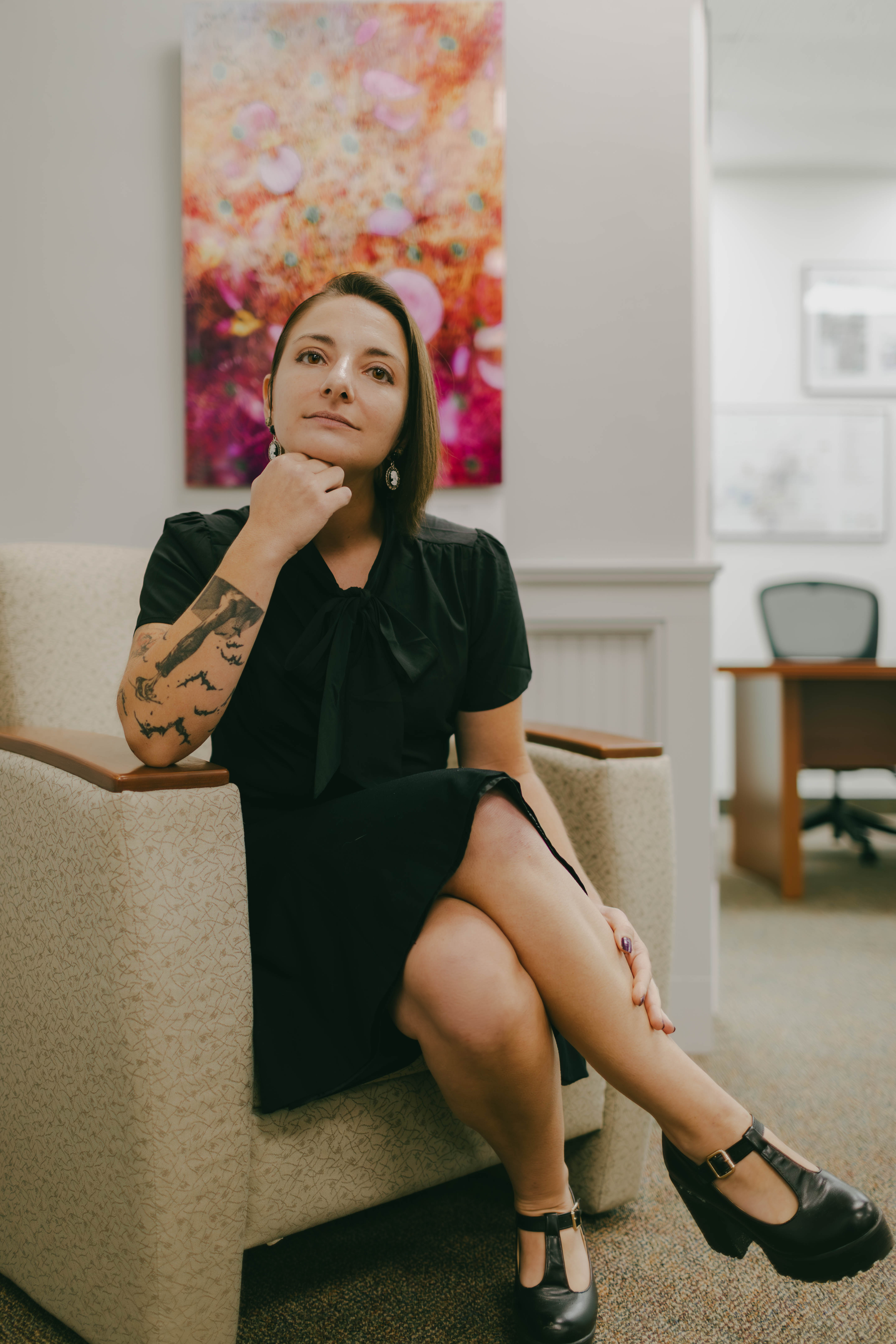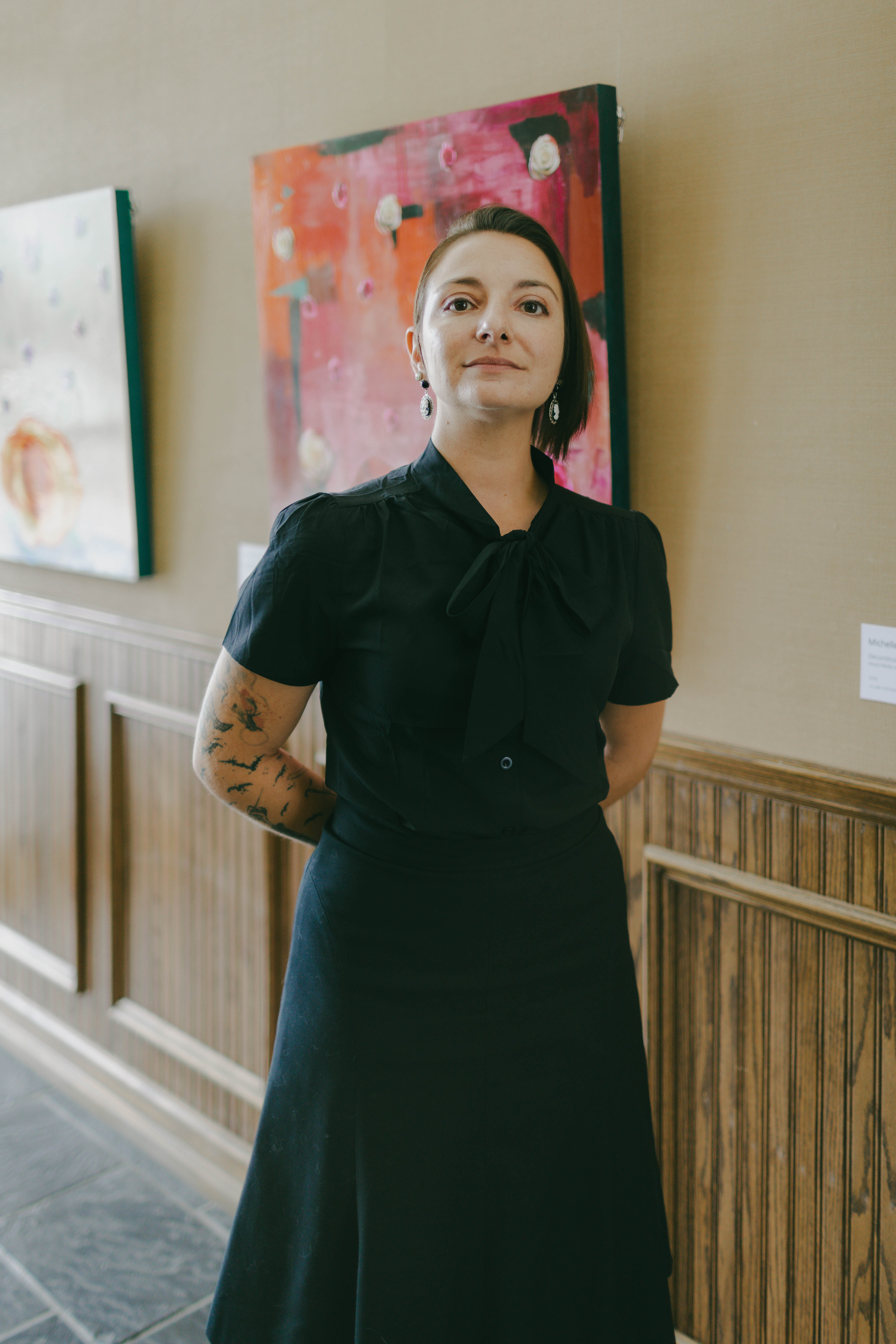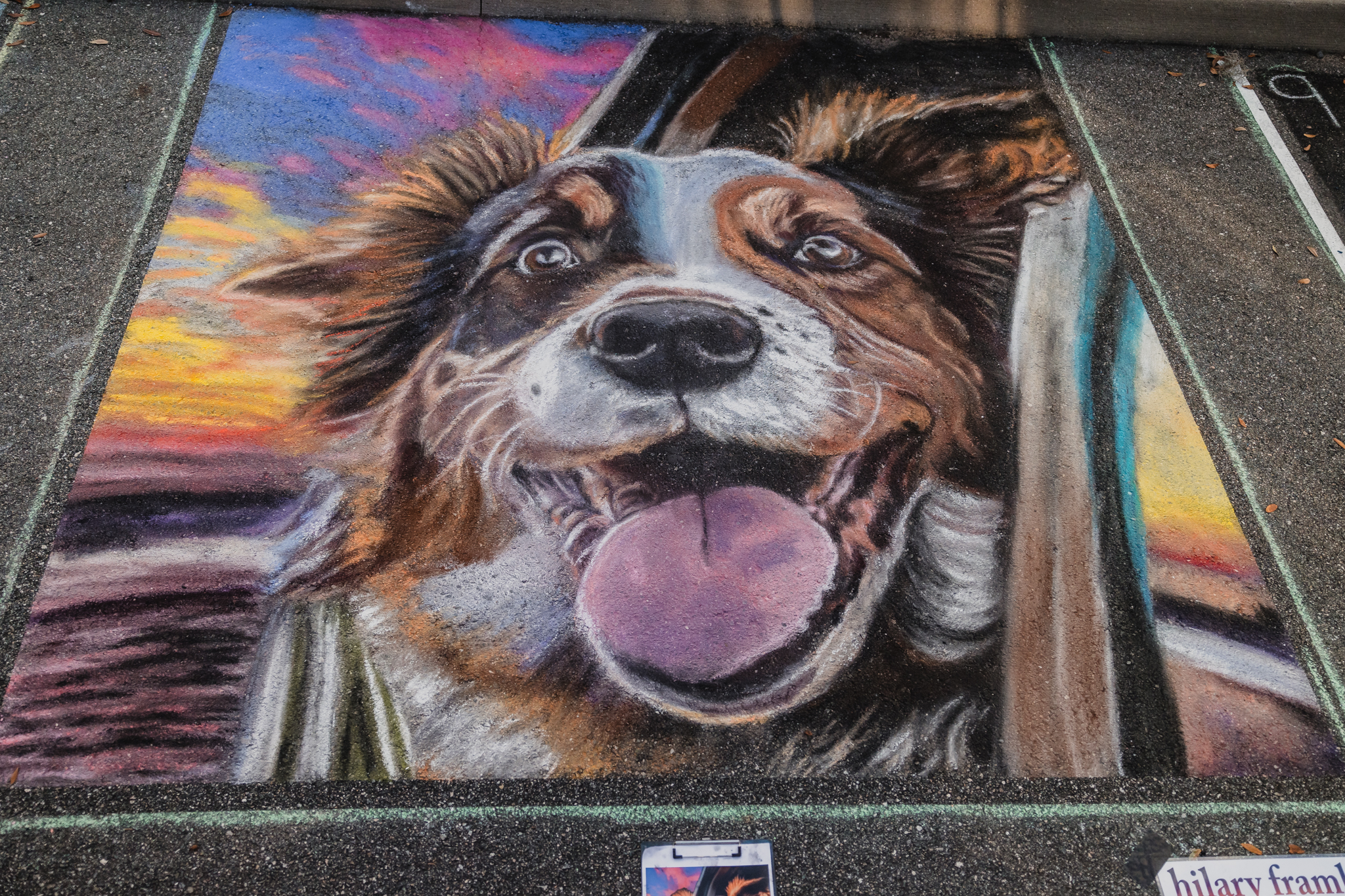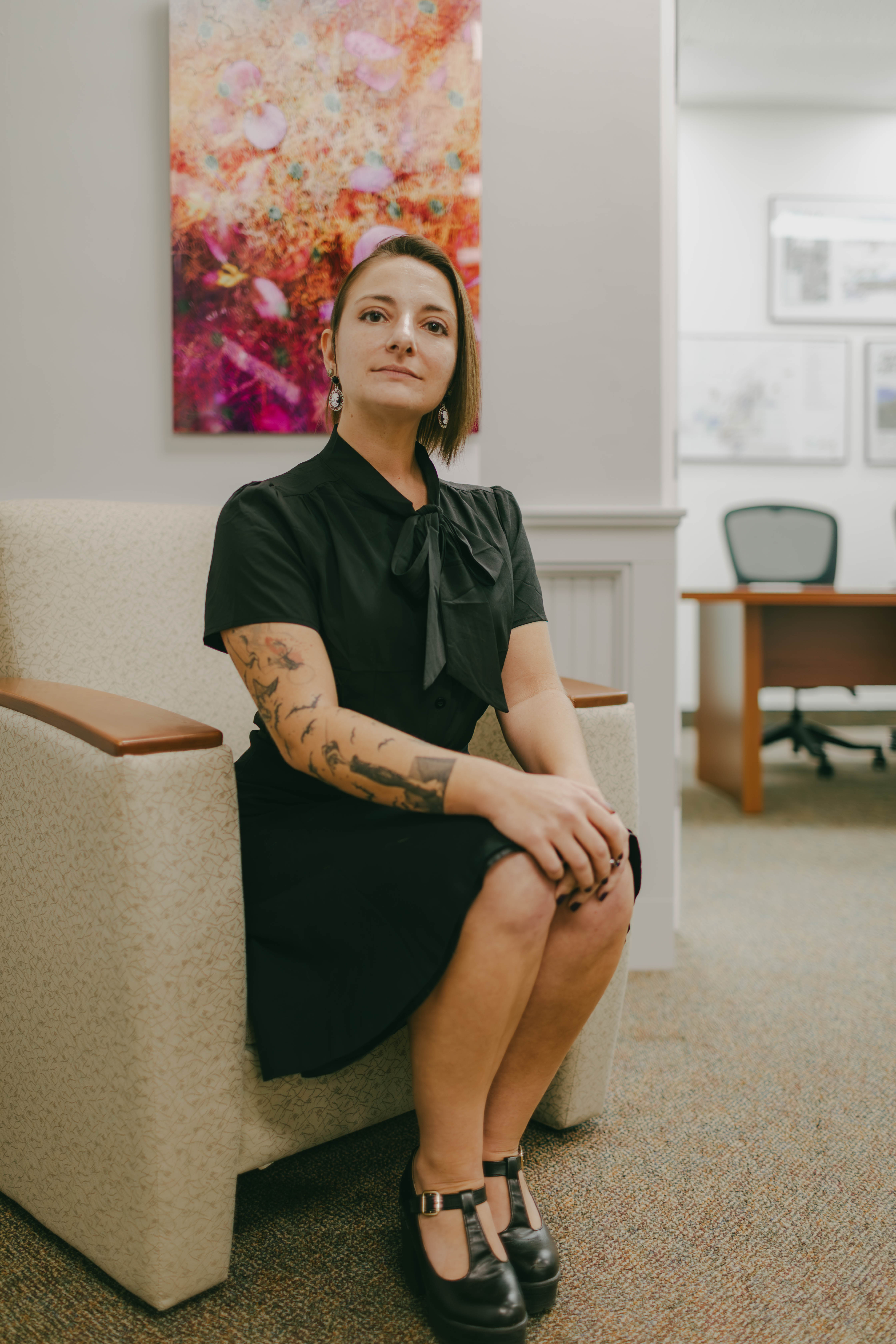
WRITTEN BY: DR. LESLIE HAMMOND
PHOTOGRAPHY BY: JOSHUA JACOBS
An Interview with Emily Parkman
Cultural Arts Supervisor
Growth Management
City of Ocala
Horse Fever. If you were in Ocala/Marion County in 2001, you know. And even if you’re a newcomer to the area, you can’t help but notice the colorful horse sculptures throughout our community. Perhaps you have spotted painted murals or have attended an event in Tuscawilla Park and have discovered huge sculptures. But did you know that the City of Ocala has a Cultural Arts division that oversees 160 artworks in our public spaces and owns 91 artworks in its permanent collection, including some of the Horse Fever Horses? I sat down with Emily Parkman, Cultural Arts Supervisor for the City of Ocala to understand how they acquire, care for and use the artwork not only to beautify but also create programming to engage our community.

MEET EMILY PARKMAN
LH: Emily, tell us a bit about yourself, what brought you to Ocala?
EM: I am a recent transplant to central Florida. I’ve been with the city for 3 years now and have been the Cultural Arts Supervisor for almost a year and a half of that time. I have a background in fine arts, and a Master of Fine Arts degree in painting and drawing. I have worked in various galleries as well as the Madison Museum of Contemporary Art and the Ringling College of Art and Design.
I was so excited to start with this city and grow my knowledge. I am learning through challenges and of being the liaison between government, the community and artists, but I enjoy helping the community, listening to their needs, knowing what they want to see and how the city can help.
CULTURAL ARTS ORGINS
LH: You’ve mentioned that the Cultural Arts program is young?
EM: Yes, it officially started in 2011, with Melissa Townsend. She became the first Cultural Arts Coordinator for the City of Ocala, within Recreation and Parks at that time. This was the result of the City’s 2035 vision plan. They saw the Tuscawilla area and Osceola track desperately needed a revamp. Thus, within a Recreation and Park’s Master Plan from the vision, came the 2010 Tuscawilla Master Plan that addressed how we can revitalize this area. They identified that the arts were an important component for the Tuscawilla area and Melissa Townsend came in to spearhead this revitalization, specifically at Tuscawilla first, but it branched out into all arts within the city in general.
The initial projects included a sculpture competition, around 2013, and the Art in City Spaces program in 2012. This second project consisted of creating gallery spaces within the city municipal buildings. City Hall was the first gallery space identified to display community artwork. The thought being that as people came into City Hall to do business or go to council meetings, they could engage with art.
We now program five art galleries: City Hall, the Clerk’s Office within City Hall, the Mary Sue Rich Community Center at Reed Place, Ocala’s International Airport and the Eighth Avenue Adult Activity Center.

KEY CULTURAL ARTS EVENTS
LH: The Cultural Arts Division oversees other projects and events, correct?
EM: Yes, like the First Friday Art Walk. It was started by private citizens wanting to see artists in the streets to activate the downtown area. However, the city started working closely with those who were doing the art walk and then eventually took that on as a city obligation. Taking on the Art Walk expanded our staff to support the additional events and programming. The First Friday Art Walk takes place on the first Friday of each month, October through May, from 6 to 9 p.m. and is located within Ocala’s historic downtown. This free event includes not only artist displays but live music, family-friendly art activities and extended downtown shop hours.
LH: What are some of the activities going on in and around Tuscawilla Park?
EP: We have the Tuscawilla Art Park Series (TAPS). This series hosts cultural events in Tuscawilla Art Park to help activate the park and immediate area. Next to the historic Ocala Union Station (where you can also find MAX – the Magnolia Art Xchange, where emerging artist have studios), the art park is located at 213 NE 5th Street. There is a stage in the park where we have previously hosted a series of concerts. Current programing includes not only the Ocala Outdoor Sculpture Competition and Tuscawilla Sculpture Stroll (February 21, 2026), but the Art Outside the Lines Brunch, and the OTrak Chalk Walk (January 24, 2026). Next year we will initiate an event in collaboration with Marion County’s public library system, about which we’re very excited.
LH: You did a national call to artist this summer for the Ocala Sculpture Competition, correct?
EP: Yes, initially, as I mentioned, the competition began in 2013. Instead of it being an annual event, it’s every other year, because of just how much work goes into having competitions. It’s managing the call to artists, the jurying process to select the winners. Then it is coordinating the shipment and installation of the sculptures and then coordinating events. We have two events to celebrate the competition; one is a free sculpture stroll with interactively fun guided tours. The other is a paid VIP experience with artist talks occurring in tandem with the stroll.
LH: And that’s happening when?
EM: February 21, 2026. Through these series and events, we are trying to help activate these areas and help people enjoy the public art, feel safe, and proud of their community.
ECONOMIC IMPACT
LH: Our community has blossomed, and that has a lot to do with art and cultural programming, which in turn supports economic development.
EM: In 2023 there was an Arts & Economic Prosperity study conducted by Americans for the Arts which concluded that for every dollar spent on cultural arts in Ocala, it yielded a $2.35 return on investment. Whether you are going to city events or events at the Appleton Museum or the Riley Arts Center, that’s what study analyzed, and it showed that the average person spent about $29 per event, not including ticket prices. This money goes back into our local economy.
PUBLIC ART COLLECTION & MANAGEMENT
LH: Let’s talk a little bit about the public art collection that the city owns.
EM: Sure, there are 91 permanent collection pieces.
LH: Anyone can go to the Cultural Art’s website anytime and look at the entire collection online!
EM: Exactly, and it not just the collection. The website also illustrates the short-term loans that we have from the sculpture competition, as well as art exhibited in city galleries, part of the Art in City Spaces program.
LH: And that includes some of the horses from the Horse Fever project, right?
EM: Yes, we oversee 12 at the city, but we only own three of them while the others are on a long-term loan agreement. Basically, that means that the horse is displayed on city property, and the city does the maintenance, but we don’t own it, it belongs to the original purchaser of that horse.
LH: The Horse Fever project was spearheaded by what became the Marion Cultural Alliance. With the money they raised from that initial project, they’ve been giving back money through annual grants to support programs and events in our community.
EP: Yes, they are a great partner with the city.
OMAC
LH: Would you please describe a little bit about OMAC, the Ocala Municipal Arts Commission?
EM: Sure, Ocala Municipal Arts Commission (OMAC) was established in 1961 by Ocala City Council to enhance cultural and artistic development of Ocala as well as an arts advisory agency for the city and its citizens. In June 1992, wishing to extend their outreach of the arts into the county, the Commission was designated the official Local Arts Agency for Marion County by the Marion County Board of County Commissioners. OMAC counsels and guides city policies in connection with artistic and cultural development in Ocala. The eleven members are comprised of representatives from the fine and performing arts, nonprofit arts, administration, local business leaders and community members at large. To ensure the commission provides broad knowledge and is representative of Ocala’s community, six of the board seats are reserved for representation from the College of Central Florida, Fine Arts for Ocala (FAFO), Marion County public schools, Marion Cultural Alliance, the Ocala Civic Theater, and the Ocala Symphony Orchestra. Since OMAC is Marion County’s official local arts agency, OMAC and the City entered into an agreement with the state of Florida to receive state funding through the “State of the Arts” Florida Specialty License Plates Program to fund and support art organizations, programs, and activities within Marion County in 1997. With this newly acquired funding, OMAC created a grant program for artists, art organizations, and non-profits to apply to assist with arts projects and program funding thereby increasing and encouraging the cultural and artistic development within Ocala and Marion County. Since beginning this highly successful grant program, OMAC has helped numerous organizations and individuals throughout Ocala and Marion County with grants totaling over $125,768 (2025).
LH: That’s awesome! Are the art grants for artists only, or could it be cultural events as well?
EM: Correct, it could be a local artist or a collective, or a nonprofit that would be applying for arts or cultural program events projects, anything that will benefit Marion County.
CULTURAL ARTS STAFF AND RESOURCES
LH: What else would you like to share?
EM: Oh, the Ocala Cultural Arts division currently has a staff of four people, including myself. I am the Cultural Arts Supervisor and then I have two Cultural Art Coordinators. Mariana Rubio Prieto, Cultural Arts Coordinator – Events and Jamie Antonetti, Cultural Arts Coordinator – Public Art. We also have our Exhibit Technician who helps maintain and oversee the public art collection, to make sure that we are cleaning it, maintaining it well so it will last as long as it possibly can.
LH: Well Emily, thank you so much for sharing about how the city supports the cultural arts in our community. I think it’s fair to say that we are no longer “SLOCALA.”
Ocala Cultural Art is a division of City of Ocala’s Growth Management Department. Their mission statement: Cultural arts are essential to the community’s long-term growth, economic development, and identity. The City of Ocala Cultural Arts mission is to provide an outlet for lifelong learning, enliven public spaces, and instill community pride.

